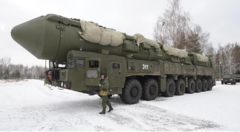RS-26 Rubezh
(missile) | |
|---|---|
 | |
The RS-26 Rubezh, designated by NATO as SS-X-31, is a new Russian hypersonic intercontinental ballistic missile (ICBM).[1] It is equipped with a thermonuclear MIRV or MaRV payload, and is also intended to be capable of carrying the Avangard hypersonic glide vehicle.
The RS-26 missile has been criticised by Western defence observers for indirectly breaching the Intermediate-Range Nuclear Forces Treaty (INF Treaty).[2]
Background
The RS-26 is based on RS-24 Yars, and constitutes a shorter version of the RS-24 with one fewer stages. The development process of the RS-26 has been largely comparable to that of the RSD-10 Pioneer, a shortened derivative of the RT-21 Temp 2S. Deployment of the RS-26 is speculated to have a similar strategic impact as the RSD-10.
Test launch?
According to Ukrainska Pravda, on 20 November 2024, speculation arose in the media regarding the possibility of Russia testing the RS-26 Rubezh ballistic missile. Reports suggested that it could have been either a test launch from the Kapustin Yar range in Astrakhan Oblast or a combat launch.
According to the Ukrainian Air Force, on 21 November 2024 the Russian Federation launched an unspecified number of RS-26 missiles without nuclear warheads at Ukraine, reportedly targeting critical infrastructure in the central Ukrainian city of Dnipro. Russian government spokesperson Dmitry Peskov was asked to confirm this, and replied that he "had nothing to say on this topic".
A western official stated that the missile used in the attack in question was not an ICBM but a standard ballistic missile.[3]
References
Wikipedia is not affiliated with Wikispooks. Original page source here